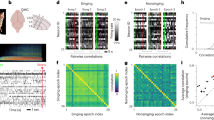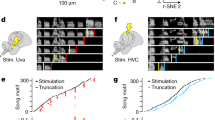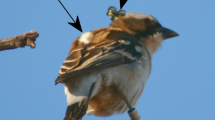Abstract
Quantitative biomechanical models can identify control parameters that are used during movements, and movement parameters that are encoded by premotor neurons. We fit a mathematical dynamical systems model including subsyringeal pressure, syringeal biomechanics and upper-vocal-tract filtering to the songs of zebra finches. This reduces the dimensionality of singing dynamics, described as trajectories (motor ‘gestures’) in a space of syringeal pressure and tension. Here we assess model performance by characterizing the auditory response ‘replay’ of song premotor HVC neurons to the presentation of song variants in sleeping birds, and by examining HVC activity in singing birds. HVC projection neurons were excited and interneurons were suppressed within a few milliseconds of the extreme time points of the gesture trajectories. Thus, the HVC precisely encodes vocal motor output through activity at the times of extreme points of movement trajectories. We propose that the sequential activity of HVC neurons is used as a ‘forward’ model, representing the sequence of gestures in song to make predictions on expected behaviour and evaluate feedback.
This is a preview of subscription content, access via your institution
Access options
Subscribe to this journal
Receive 51 print issues and online access
$199.00 per year
only $3.90 per issue
Buy this article
- Purchase on Springer Link
- Instant access to full article PDF
Prices may be subject to local taxes which are calculated during checkout






Similar content being viewed by others
References
Hatsopoulos, N. G., Xu, Q. & Amit, Y. Encoding of movement fragments in the motor cortex. J. Neurosci. 27, 5105–5114 (2007)
Nishikawa, K. et al. Neuromechanics: an integrative approach for understanding motor control. Integr. Comp. Biol. 47, 16–54 (2007)
Perl, Y. S., Arneodo, E. M., Amador, A., Goller, F. & Mindlin, G. B. Reconstruction of physiological instructions from Zebra finch song. Phys. Rev. E 84, 051909 (2011)
Dave, A. S. & Margoliash, D. Song replay during sleep and computational rules for sensorimotor vocal learning. Science 290, 812–816 (2000)
Hahnloser, R. H. R., Kozhevnikov, A. A. & Fee, M. S. An ultra-sparse code underlies the generation of neural sequences in a songbird. Nature 419, 65–70 (2002)
Prather, J. F., Peters, S., Nowicki, S. & Mooney, R. Precise auditory-vocal mirroring in neurons for learned vocal communication. Nature 451, 305–310 (2008)
Yu, A. C. & Margoliash, D. Temporal hierarchical control of singing in birds. Science 273, 1871–1875 (1996)
Margoliash, D. Acoustic parameters underlying the responses of song-specific neurons in the white-crowned sparrow. J. Neurosci. 3, 1039–1057 (1983)
Margoliash, D. Preference for autogenous song by auditory neurons in a song system nucleus of the white-crowned sparrow. J. Neurosci. 6, 1643–1661 (1986)
Shank, S. S. & Margoliash, D. Sleep and sensorimotor integration during early vocal learning in a songbird. Nature 458, 73–77 (2009)
Amador, A., Goller, F. & Mindlin, G. B. Frequency modulation during song in a suboscine does not require vocal muscles. J. Neurophysiol. 99, 2383–2389 (2008)
Elemans, C. P. H., Laje, R., Mindlin, G. B. & Goller, F. Smooth operator: avoidance of subharmonic bifurcations through mechanical mechanisms simplifies song motor control in adult zebra finches. J. Neurosci. 30, 13246–13253 (2010)
Fee, M. S., Shraiman, B., Pesaran, B. & Mitra, P. P. The role of nonlinear dynamics of the syrinx in the vocalizations of a songbird. Nature 395, 67–71 (1998)
Mindlin, G. B. & Laje, R. The Physics of Birdsong. (Springer Verlag, 2005)
Laje, R., Gardner, T. J. & Mindlin, G. B. Neuromuscular control of vocalizations in birdsong: A model. Phys. Rev. E 65, 05192 (2002)
Sitt, J. D., Amador, A., Goller, F. & Mindlin, G. B. Dynamical origin of spectrally rich vocalizations in birdsong. Phys. Rev. E 78, 011905 (2008)
Amador, A. & Mindlin, G. B. Beyond harmonic sounds in a simple model for birdsong production. Chaos 18, 043123 (2008)
Riede, T., Suthers, R. A., Fletcher, N. H. & Blevins, W. E. Songbirds tune their vocal tract to the fundamental frequency of their song. Proc. Natl Acad. Sci. USA 103, 5543–5548 (2006)
Hartley, R. S. & Suthers, R. A. Air-flow and pressure during canary song: direct evidence for mini-breaths. J. Comp. Physiol. A 165, 15–26 (1989)
Suthers, R. A., Goller, F. & Wild, J. M. Somatosensory feedback modulates the respiratory motor program of crystallized birdsong. Proc. Natl Acad. Sci. USA 99, 5680–5685 (2002)
Wild, J. M. Functional neuroanatomy of the sensorimotor control of singing. Ann. NY Acad. Sci. 1016, 438–462 (2004)
Suthers, R. A., Goller, F. & Pytte, C. The neuromuscular control of birdsong. Phil. Trans. R. Soc. B 354, 927–939 (1999)
Fee, M. S., Kozhevnikov, A. A. & Hahnloser, R. H. Neural mechanisms of vocal sequence generation in the songbird. Ann. NY Acad. Sci. 1016, 153–170 (2004)
Kozhevnikov, A. A. & Fee, M. S. Singing-related activity of identified HVC neurons in the zebra finch. J. Neurophysiol. 97, 4271–4283 (2007)
Fiete, I. R., Hahnloser, R. H. R., Fee, M. S. & Seung, H. S. Temporal sparseness of the premotor drive is important for rapid learning in a neural network model of birdsong. J. Neurophysiol. 92, 2274–2282 (2004)
Vu, E. T., Mazurek, M. E. & Kuo, Y. C. Identification of a forebrain motor programming network for the learned song of zebra finches. J. Neurosci. 14, 6924–6934 (1994)
Williams, H. & Vicario, D. S. Temporal patterning of song production: Participation of nucleus uvaeformis of the thalamus. J. Neurobiol. 24, 903–912 (1993)
Margoliash, D. & Fortune, E. S. Temporal and harmonic combination-sensitive neurons in the zebra finch's HVc. J. Neurosci. 12, 4309–4326 (1992)
Nick, T. A. & Konishi, M. Neural auditory selectivity develops in parallel with song. J. Neurobiol. 62, 469–481 (2005)
Prather, J. F., Nowicki, S., Anderson, R. C., Peters, S. & Mooney, R. Neural correlates of categorical perception in learned vocal communication. Nature Neurosci. 12, 221–228 (2009)
Brainard, M. S. & Doupe, A. J. Interruption of a basal ganglia-forebrain circuit prevents plasticity of learned vocalizations. Nature 404, 762–766 (2000)
Ölveczky, B. P., Andalman, A. S. & Fee, M. S. Vocal experimentation in the juvenile songbird requires a basal ganglia circuit. PLoS Biol. 3, e153 (2005)
Konishi, M. The role of auditory feedback in the control of vocalization in the white-crowned sparrow. Z. Tierpsychol. 22, 770–783 (1965)
Ashmore, R. C., Wild, J. M. & Schmidt, M. F. Brainstem and forebrain contributions to the generation of learned motor behaviors for song. J. Neurosci. 25, 8543–8554 (2005)
Wolpert, D. M., Ghahramani, Z. & Jordan, M. I. An internal model for sensorimotor integration. Science 269, 1880–1882 (1995)
Roberts, T. F., Klein, M. E., Kubke, M. F., Wild, J. M. & Mooney, R. Telencephalic neurons monosynaptically link brainstem and forebrain premotor networks necessary for song. J. Neurosci. 28, 3479–3489 (2008)
Coleman, M. J., Roy, A., Wild, J. M. & Mooney, R. Thalamic gating of auditory responses in telencephalic song control nuclei. J. Neurosci. 27, 10024–10036 (2007)
Bauer, E. E. et al. A synaptic basis for auditory-vocal integration in the songbird. J. Neurosci. 28, 1509–1522 (2008)
Mulliken, G. H., Musallam, S. & Andersen, R. A. Forward estimation of movement state in posterior parietal cortex. Proc. Natl Acad. Sci. USA 105, 8170–8177 (2008)
Leyton, S. S. & Sherrington, C. S. Observations on the excitable cortex of the chimpanzee, orangutan and gorilla. Q. J. Exp. Physiol. 11, 135–222 (1917)
Sutter, M. L. & Margoliash, D. Global synchronous response to autogenous song in zebra finch HVC. J. Neurophysiol. 72, 2105–2123 (1994)
Press, W. H., Teukolsky, S. A., Vetterling, W. T. & Flannery, B. P. Numerical Recipes: The Art of Scientific Computing 3rd edn (Cambridge Univ. Press, 2007)
Guckenheimer, J. & Holmes, P. Nonlinear Oscillations, Dynamical Systems, and Bifurcations of Vector Fields. (Springer Verlag, 1997)
Fletcher, N. H., Riede, T. & Suthers, R. A. Model for vocalization by a bird with distensible vocal cavity and open beak. J. Acoust. Soc. Am. 119, 1005–1011 (2006)
Daley, M. & Goller, F. Tracheal length changes during zebra finch song and their possible role in upper vocal tract filtering. J. Neurobiol. 59, 319–330 (2004)
Acknowledgements
We are grateful to R. H. R. Hahnloser for help with the microdrives and techniques used to record from singing birds. We thank H. D. I. Abarbanel, T. Q. Gentner, H. C. Nusbaum and S. E. Palmer for valuable comments on the manuscript. This work was supported by a Human Frontiers Science Program cross-disciplinary fellowship award to A.A., NIDCD006876, ANCyT, CONICET and UBA awards to G.B.M. and Y.S.P., and NIDCD and NSF/CRCNS awards to D.M.
Author information
Authors and Affiliations
Contributions
Author Contributions A.A., G.B.M. and Y.S.P. developed the syringeal model, G.B.M. and Y.S.P. modelled the songs, A.A. conducted surgeries, sound recordings and collected the electrophysiological data, A.A., G.B.M. and D.M. conceived and designed the experiments, and prepared the manuscript. All four authors participated in data analysis.
Corresponding author
Ethics declarations
Competing interests
The authors declare no competing financial interests.
Supplementary information
Supplementary Information
This file contains Supplementary Text, additional references and Supplementary Figures 1-8. (PDF 2660 kb)
Rights and permissions
About this article
Cite this article
Amador, A., Perl, Y., Mindlin, G. et al. Elemental gesture dynamics are encoded by song premotor cortical neurons. Nature 495, 59–64 (2013). https://doi.org/10.1038/nature11967
Received:
Accepted:
Published:
Issue Date:
DOI: https://doi.org/10.1038/nature11967
This article is cited by
-
The generative grammar of the brain: a critique of internally generated representations
Nature Reviews Neuroscience (2024)
-
Syringeal vocal folds do not have a voice in zebra finch vocal development
Scientific Reports (2021)
-
Universal principles underlying segmental structures in parrot song and human speech
Scientific Reports (2021)
-
Speech rhythms and their neural foundations
Nature Reviews Neuroscience (2020)
-
Intrinsic neuronal properties represent song and error in zebra finch vocal learning
Nature Communications (2020)
Comments
By submitting a comment you agree to abide by our Terms and Community Guidelines. If you find something abusive or that does not comply with our terms or guidelines please flag it as inappropriate.



